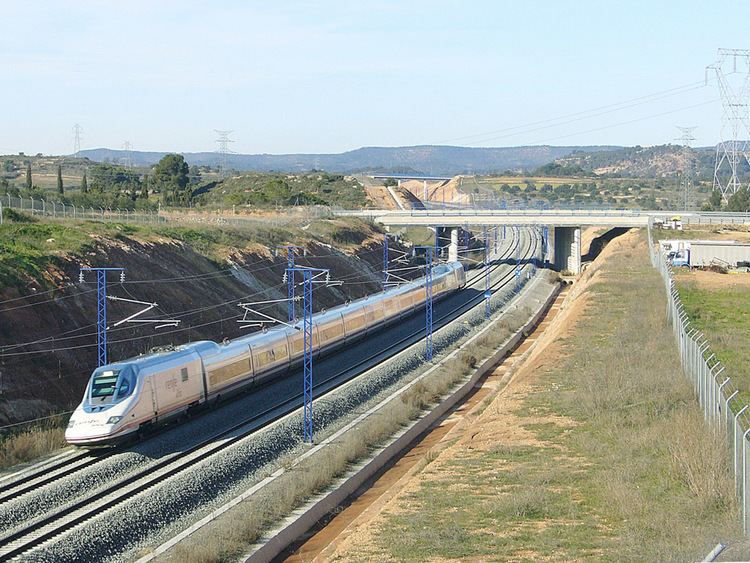Rail transport in Spain operates on four rail gauges and services are operated by a variety of private and public operators. The total route length in 2012 was 16,026 km (10,182 km electrified).
Most railways are operated by Renfe Operadora; metre and narrow-gauge lines are operated by FEVE and other carriers in individual autonomous communities. It is proposed and planned to build or convert more lines to standard gauge, including some dual gauging of broad-gauge lines, especially where these lines link to France, including platforms to be heightened.
Spain is a member of the International Union of Railways (UIC). The UIC Country Code for Spain is 71.
The first railway line in the Iberian Peninsula was built in 1848 between Barcelona and Mataró. In 1851 the Madrid-Aranjuez line was opened. In 1852 the first narrow gauge line was built; in 1863 a line reached the Portuguese border. By 1864 the Madrid-Irun line had been opened, and the French border reached.
In 1900 the first line to be electrified was the La Poveda-Madrid.
In 1941 RENFE was created.
The last steam locomotive was withdrawn in 1975, in 1986 the maximum speed on the railways was raised to 160 km/h, and in 1992 the Madrid-Seville high-speed line opened, beginning the process of building a nationwide high-speed network.
The current plans of the Spanish government plans to link all the provincial capitals with high-speed rail, with a total estimated length of over 9000 km of high-speed railways for 2020.
Renfe Operadora is the state-owned company which operates freight and passenger trains on the 1,668 mm (5 ft 5 21⁄32 in) "Iberian gauge" and 1,435 mm (4 ft 8 1⁄2 in) standard gauge networks of the Spanish nationalized infrastructure company ADIF (Spanish: Administrador de Infraestructuras Ferroviarias). Both were formed from the break-up of the former national carrier RENFE (Spanish: Red Nacional de los Ferrocarriles Españoles, "Spanish National Railway Network").FEVE (Spanish: Ferrocarriles Españoles de Vía Estrecha, "Narrow-Gauge Spanish Railways") is another state-owned Spanish railway company, which operates most of Spain's 1,250 km (780 mi) of narrow gauge rail.EuskoTren (Basque: Eusko Trenbideak, Spanish: Ferrocarriles Vascos, "Basque Railways") operates trains on part of the narrow gauge railway network in the Basque Country.FGC (Catalan: Ferrocarrils de la Generalitat de Catalunya, "Catalan Government Railways") operates several unconnected lines in Catalonia. It operates 140 km (87 mi) of narrow gauge, 42 km (26 mi) of standard gauge, and 89 km (55 mi) of Iberian gauge routes, two metre gauge rack railways and four funicular railways.FGV (Valencian: Ferrocarrils de la Generalitat Valenciana, "Valencian Government Railways") operates several metre gauge lines in the Valencian Community.FS (Catalan: Ferrocarril de Sóller, "Sóller Railways") operates an electrified 914 mm (3 ft) narrow gauge railway on the Spanish island of Majorca between the towns of Palma and Sóller.SFM (Catalan: Serveis Ferroviaris de Mallorca, "Majorcan Railway Servicies") operates the 1,000 mm (3 ft 3 3⁄8 in) metre gauge railway network on the Spanish island of Majorca.Acciona Rail Services, a subsidiary of Acciona, operates a coal cargo line between Asturias and the province of León.COMSA Rail Transport, a subsidiary of COMSA, operates a cargo line from the Port of Gijón to Valladolid.Continental Rail is dedicated to bringing materials into the gorges of the high-speed lines in progress.Alicante (Alicante Tram)Barcelona (Barcelona Metro/Tram)Bilbao (Bilbao Metro/Tram)A Coruña under construction.Granada (Granada Tram) under construction.Jaén (Jaén Tram) finished without service by political reason.Madrid (Madrid Metro)Málaga (Málaga Metro)Murcia (Murcia Tram) opened in 2007.Palma (Palma Metro)Parla (Parla Tram)Santa Cruz de Tenerife opened in 2007.Seville (Seville Metro/Tram)Valencia (Valencia Metro)Vélez-Málaga Tram (defunct)Vigo under construction.Vitoria-Gasteiz (Vitoria-Gasteiz Tram)Zaragoza (Zaragoza Tram) opened in 2011.In Spain there is an extensive 1,250 km (780 mi) system of metre gauge railways
High-speed standard gauge
Córdoba–Málaga high-speed rail lineMadrid–Barcelona high-speed rail lineMadrid–Sevilla high-speed rail lineMadrid–Valladolid high-speed rail lineMadrid–Levante high-speed rail line (Madrid–Valencia and Albacete)France – break-of-gauge 1,668 mm (5 ft 5 21⁄32 in)/1,435 mm (4 ft 8 1⁄2 in) (new high-speed line links without any break-of-gauge)Portugal – yes, same gaugeGibraltar (UK) – no current rail system in Gibraltar, although accessible via buses from La Línea to San Roque station.Morocco – no access to mainland (proposed undersea tunnel)Closest station to Melilla - Beni AnsarClosest station to Ceuta - Tangier-Med stationAndorra has no rail system.
In 2004, the Spanish government adopted a new strategic plan for transportation through 2020 called the PEIT (Strategic Plan for Infrastructures and Transport). This detailed rail subsidies of around €9.3 billion annually on average from 2005-2020. In 2010, it rolled out a two-year plan to invest an extra €11 billion each year for two years, as a part of a financial stimulus in response to the global downturn. In 2015, the federal budget for the railways was €5.1 billion.

